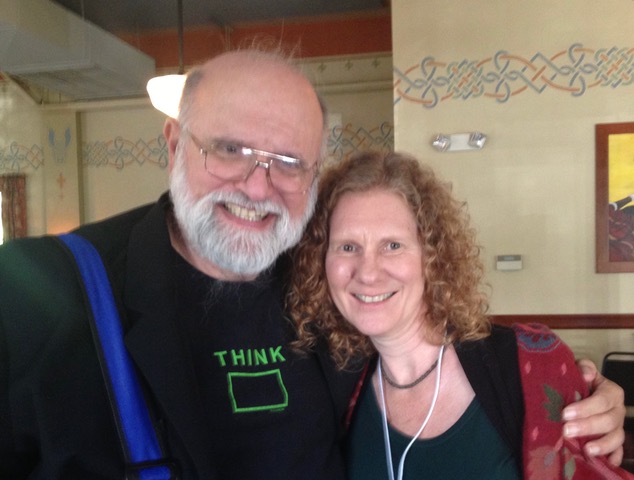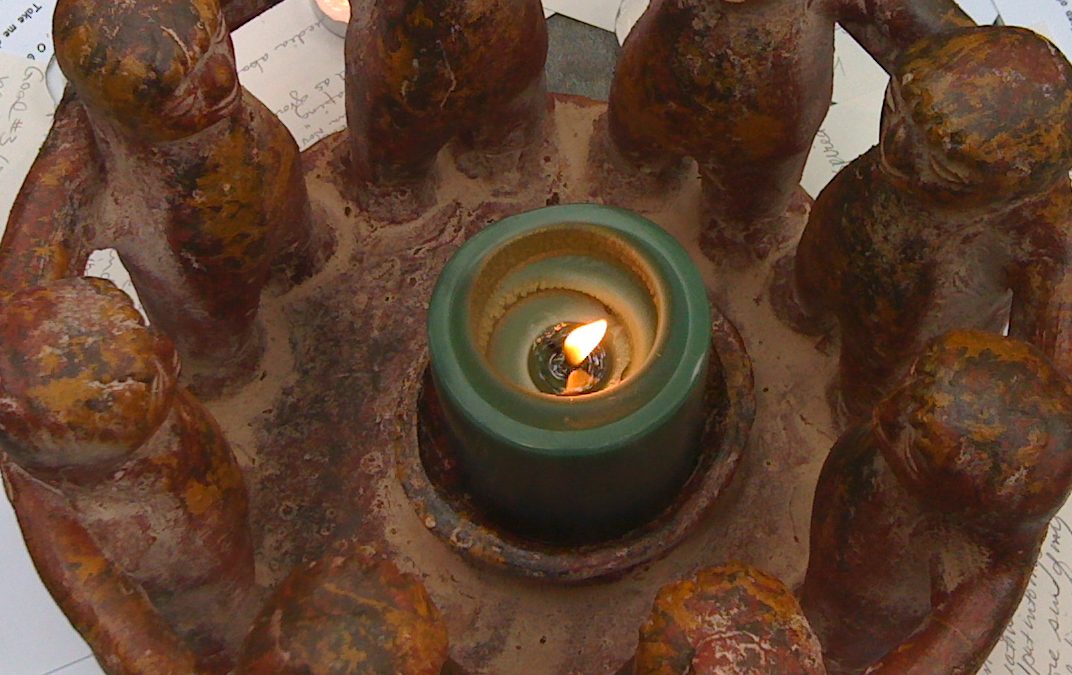If It Were My Dream: Bringing Dreams to Life with Friends
An interview with Nancy Grace
Today’s post features an interview with my friend and colleague, Nancy Grace. I met Nancy some years back at an International Association for the Study of Dreams conference, but back then she lived in Santa Fe, so we remained what we call “conference buddies.” Then she moved to western Massachusetts, not far from where I live, and where she has some roots as well. Now, Nancy and I are teaming up on a brand-new dreamy offering. On Oct. 15, we’ll be leading a full-day in-person workshop in Florence, Mass., titled Bringing Dreams to Life: Tapping into Creativity with Group Dreamwork and Writing. You can get all the details, including Nancy’s biography, here.
Read on to learn about Nancy’s dreamwork training with Jeremy Taylor, how nightmares have helped her, and more.

Following in the footsteps of a pioneer in group dreamwork
TZIVIA: Nancy it’s so good to be with you. I’m looking forward to introducing you to my community of dreamy writers. I’ve shared a link to our course, so readers can learn more about you, but this is a chance for them to get to know even more about who you are and your relationship to dreams and dreamwork. One of the things that I love knowing about you is that you trained with Jeremy Taylor. A lot of people reading this might not know who he was, so I wonder if you’d introduce us to him, and what your relationship with him was.
NANCY: Sure! Jeremy Taylor, who sadly passed away in 2018, was one of the few pioneers of group dreamwork in this country. In terms of people out there teaching a group process, for many years it was Montague Ullman, who was a psychiatrist, and Jeremy, who was a Unitarian Universalist minister. Their processes are quite different, though they do have elements in common, most famously the use of the phrase “if it were my dream.” For Jeremy, the point of this is that when commenting on another person’s dream, you never try to tell that person what their dream means, or say “you” or “your dream.” You always own your projection, as Jeremy would say. In fact, he calls his process Projective Dreamwork, to acknowledge that whenever we have an idea about someone else’s dream, it’s a projection. Whether we say it out loud or not, we’re implicitly saying “if this were my dream, here’s what it would mean to me.” So he became known for that (although in later years he preferred to say “in my imagined version of your dream . . . ”).

Photo courtesy of Nancy Grace, seen here with Jeremy Taylor in 2016
If it were my dream
TZIVIA: This process of projective dreamwork will be new to a lot of people. One way I think about it is that when I say “if it were my dream,” it stops me from telling somebody else what their dream means, and instead, I experience it as my own. When I do that as a dream group member, I’m getting as much out of somebody else’s dream as they are, because I’ve really taken it into myself imaginatively. The dream comes alive in me, so I’m speaking about my experience. It might spark something for the dreamer, and it might not – but that’s for the dreamer to say.
NANCY: Exactly! I have a great story from my early days training with Jeremy when that became so clear. Jeremy would always point out that when we say “if it were my dream” we really are doing our own work in projected form. As he used to say, when someone tells a dream, there are so many things that are interesting, but different members of a group will find different things interesting. That’s because of projection! So my story is that in a dream group he was leading, a woman told her dream, and as usual many people around the circle were offering projections on the dream. But there was one woman who made several comments, and they were all about motherhood. While other people weren’t seeing motherhood themes in the dream, she was, and it was clear to her and to the group that this was because motherhood was a current and important issue for her, so it was easy for her to see that in the dream.
TZIVIA: That’s so interesting! You know, one of the stories that I love that Jeremy used to tell a lot, and it’s in his book, Where People Fly and Water Runs Uphill (he also has an updated version of that book, called The Wisdom of Your Dreams)—is about somebody in a dream group who said he didn’t have a dream that day—he didn’t have anything. Jeremy encouraged him to dig deeper, and then he said that he maybe had a memory of one thing: pastel colors. And so the group worked on that. They considered various associations to pastel colors. And that process put the dreamer in touch with deep ambivalence he hadn’t been acknowledging about major life choices he’d made. He actually changed his life as a result of the dreamwork that day.
So I learned from Jeremy Taylor, in addition to the projective dreamwork process, that we don’t need to remember a whole epic dream. People who don’t remember much about dreams at all can get so much benefit.
Now I’d like to ask if you can share a story from your own life about how you’ve benefited from group dreamwork.
The healing power of group dreamwork
NANCY: Sure. You won’t be surprised to hear that group dreamwork has been enormously beneficial for me! And just so people know, I met Jeremy at one of his workshops in 1992, where I immediately knew that he was the teacher I’d been looking for. So it’s been a long time. But one of the most transformational experiences I had was at one of the early workshops I took with him, where I worked with a nightmare. Jeremy believed that while nightmares of course are frightening, this is not because their messages are inherently “bad,” but rather because their messages are so important – too important in fact to risk being forgotten, and nightmares don’t usually fade from memory like so many other dreams. Jeremy believed that nightmares developed as a form of dream experience in keeping with evolutionary theory, in which we pay attention to things that feel threatening in order to ensure our survival. So despite their frightening form, nightmares can actually be quite beneficial to us if we learn to understand them.
The nightmare I worked with was from several years prior to the workshop. It had been so upsetting to me that, even as someone already quite into dreams, I didn’t even want to think about it, as the emotional complexity and awful feelings in the dream were so intense and distressing. So this seemed a perfect dream to work on. As I shared the nightmare, and people in the group asked questions and got me to talk about it and make associations, and as projections on the dream were offered, I experienced in real time the truth of Jeremy’s theory: I started to see what the metaphors and storyline of the dream might be speaking to in my waking life, and as this understanding unfolded, I watched the visceral, emotional grip of fear just dissolve!
TZIVIA: Wow, that’s amazing. And you just gave us a living example of what Jeremy Taylor taught: that all dreams come in the service of health and wholeness. And I would say especially the nightmares. Nightmares were my entry into dreams and dreamwork. I’ve always had nightmares ever since I was a small child, and I love to work with people and their nightmares because I have learned, just as you were saying, that sometimes the most healing—the most juice is there. And I agree that this is why they give that emotional punch, so that we don’t forget them, and so that we can have the opportunity to be transformed by them.
But I realize that all of this might feel like a whole new language to people who are new to dreamwork. How do you present this to people so that it’s clear and something that everybody can access? Because after all dreams come to everybody, and there’s nothing more natural than dreaming, and working in community with dreams. What are some tips or entry points you offer to people so they can feel comfortable and like this is really doable?
A simple practice
NANCY: Well one of the things that I love about Jeremy’s process of group dreamwork is that it’s very simple to learn and to practice. As he used to say, there are many wonderful ways of working with dreams that all have validity to them, but he maintained that his process is one of the best ways to start. And I have to say that it’s a very very simple process, because you don’t have to know anything about dreams or dreamwork. You don’t have to know any theories, you don’t have to have read Carl Jung or Freud or anybody. The process is simply that if you’re the dreamer, you tell your dream, and then the rest of the group just asks questions, following their own curiosity about both the dream itself and relevant things that could be going on in the dreamer’s waking life. Then as people get ideas – again projective ideas – they will offer them, saying “if this were my dream, I would think this”, or “I would find this interesting,” or “It would mean this to me as I imagine myself in your life situation.” It’s very simple, yet very profound. And a wonderful thing about working with dreams in a group is that hearing from different people with different thoughts and approaches creates an ideal forum for bringing out the richness and multilayered meanings in a given dream.
Another thing I have found is that many people who are not in the habit of sharing dreams have some anxiety about feeling vulnerable when sharing dreams. But the great thing about Jeremy’s group process is that the bottom line which provides emotional safety is that while anyone in the group—as he liked to say, within the limits of one’s imagination and one’s sense of propriety—can ask anything at all, it is understood that the dreamer is perfectly free to say to any question, “thanks, but next question” or simply “I’d rather not answer that.”
TZIVIA: I love that, there’s agency every step of the way.
NANCY: Yes there’s agency, and there’s no pressure. And it’s not a therapy group, it’s a dream group, and that’s a really important difference since dreams are so associated with the world of psychology and therapy in our culture. Because it’s not a therapy group, there’s no confronting the dreamer, there’s no thought that way at all. It’s really just that we hear the dream, we follow our curiosity, and we see where it leads each person in the group. And what typically happens through this process is that the dreamer starts to make connections. And that’s the beauty of dreams, that they bring us these narratives and images and emotions that connect to places inside us as well as to the external world we’re living in in meaningful ways! But because of the language of dreams, it can be hard to see what those connections are or how they go together. Through this wonderful process of the group’s engagement, connections start to be made.

The everyday magic of deep listening
TZIVIA: Sometimes I say it’s magic, but really what it is, and this is where the dreamwork and the writing are connected, is a process of deep listening. It’s about following curiosity, as you said.
What I love about what we’re getting ready to do together, bringing your expertise in dreamwork together with the Dreaming on the Page writing process that I teach—is bringing people to two primal human experiences: sharing and exploring dreams, and sitting around a circle telling stories from our hearts. And I’m really excited about putting the two together, and about what you’re bringing to this process, and, of course, what we’re going to dream up together!
NANCY: Me too, I’m sure it’s going to be a deep and creative experience!
- EXPERIENCE GROUP DREAMWORK AND DREAMY WRITING: Join Tzivia and Nancy for the Bringing Dreams to Life workshop in Florence, Mass., Saturday, Oct. 15.
Join the workshop. Click here.
- LEARN ABOUT YOUR DREAMS: Befriend your dreams and learn how they can help you wake to your best life with a dreamwork consultation, workshop, or class.
Discover what your dreams mean.Click here.
- READ AND GROW: Purchase one of my books on sleep & dreams, and mindfulness.
Browse books by Tzivia. Click here.
